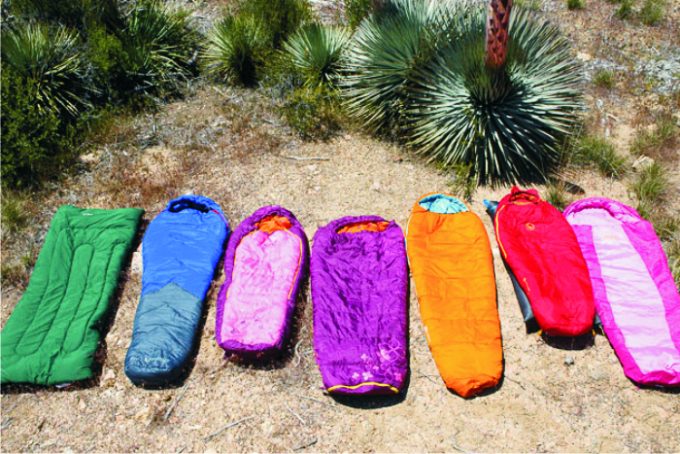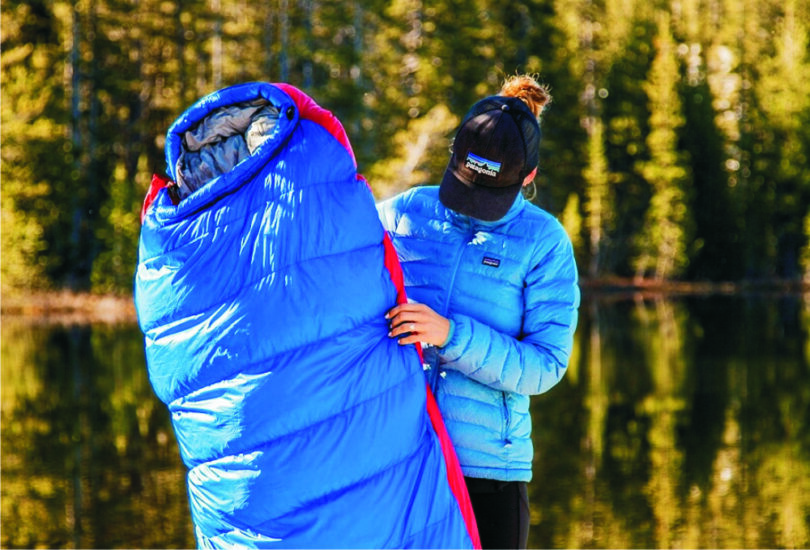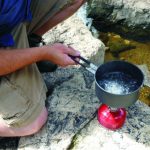You’re going on another outdoor adventure sometime soon and it occurs to you that your old sleeping bag is getting a little worn. Or you’re going on your first camping or hiking trip and need a sleeping bag to complete your kit. So, you head out to the store to buy one.
At the store you’re hit with a wide array of colors, lengths, types and most importantly: filling. The decision on whether to purchase down vs synthetic sleeping bag, is very difficult to make correctly, without the neccessary knowledge of each filling’s pros and cons.
That’s why we’ve written this article to help you understand what both down and synthetic fillings have to offer in very practical terms.
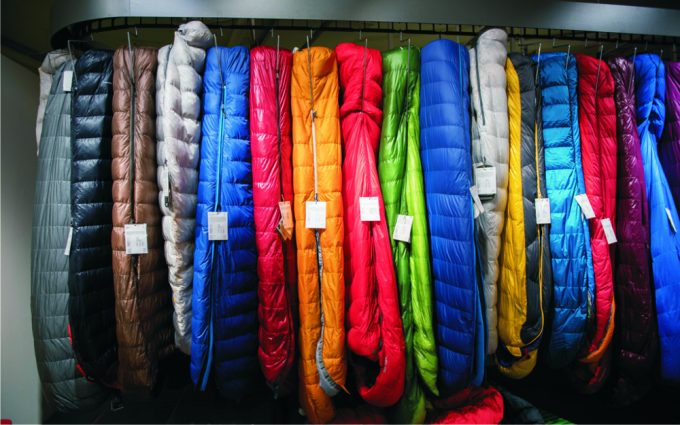
It’s worth understanding which sleeping bag is best for you as a good night’s sleep can make all the difference between an enjoyable trip and a flop. The right sleeping bag will keep you at a comfortable temperature all night long and ensure that you wake up bright eyed and bushy tailed come morning. So, how do you go about choosing the right sleeping bag?
Well the answer is quite simple. You read an informative article like this blog! Once you know what down and synthetic fillings have to offer you’ll be ready to make your choice based on your own personal circumstances.
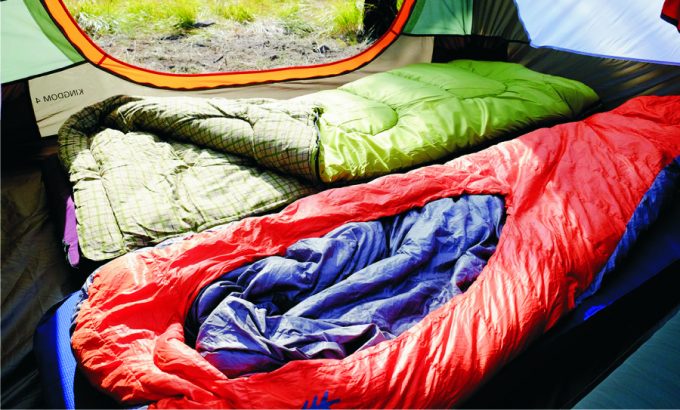
Because, as you’ll learn, either one might be perfect for you. It’s entirely a matter of your intended use situations for your new sleeping bag. So without further ado, let’s get into exploring the first of these two fillings: down.
The Characteristics Of Down Filling
What characteristics need to be considered before choosing down sleeping bag.
The Basics
First things first, you ought to know that down is made (usually entirely) from feathers. These feathers tend to be harvested from either geese or ducks. But don’t worry, it’s not their old sharp feathers that are used for flying, it’s the soft, fluffy layer of smaller feathers that these animals carry underneath their regular feathers that makes up down filling.
This layer on a bird creates an insulating midlayer which helps to keep the animal warm naturally. It works by trapping body heat in small air pockets that form within the feather clusters. Alternatively, it’s also extremely breathable! How is that possible?
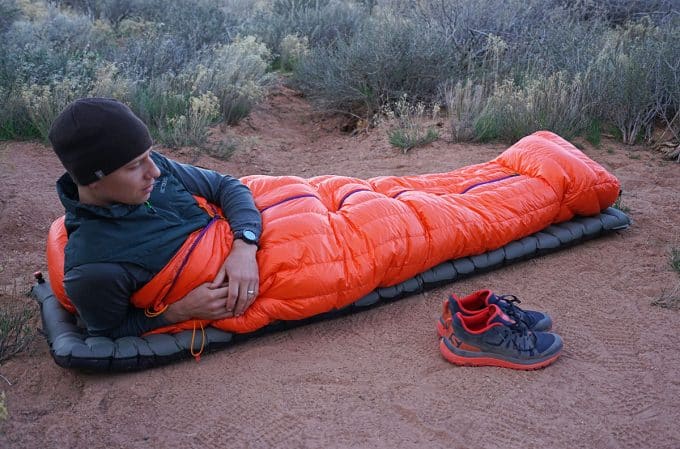
Well, we’re not entirely sure, but nature’s done it again here! Down will be warm and comfortable while allowing its surroundings to breath and it will even wick away unwanted moisture.
The Pros
Now that you’re aware of the basic characteristics of down, here are the four main positive characteristics it has in our eyes:
- Extremely lightweight
- Very compressible
- Warm
- Durable
The compact nature of down sleeping bags (their light weight, compressible structure), makes them easy to transport over long distances in your backpack. This means them the perfect companion for mountaineering or long distance hiking. You won’t find yourself cold at the end of the day with down either. Made entirely from a naturally insulating substance, down can be very warm and comfortable.

Finally, down’s durability factor is worth mentioning more strongly. A sleeping bag can be quite an investment, so it’s important that you get one that will last. Barring any problems with the exterior case’s workmanship, a good down sleeping bag can last for decades with proper care.
It’s satisfying to know that when you buy a good quality sleeping bag it will be yours for life. Clearly this is dependant on the quality of other sleeping bag parts though (zipper, lining) so you may want to consider opting for a slightly higher priced model to come out on top financially long term.
The Cons
Above, are just a few of the many benefits of down filling in sleeping bags, but as with anything, there are cons to consider as well.
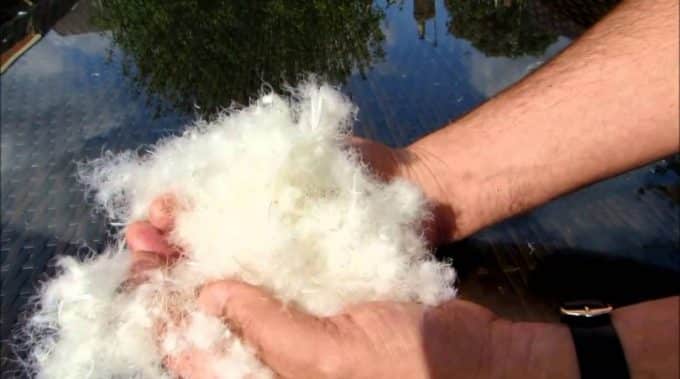
It wouldn’t be fair if we didn’t present those too, so here’s a quick list of the reasons down might not be right for you:
- Sleeping bags made from it are generally more expensive than synthetic filled ones.
- It is not hypoallergenic, meaning, those with very sensitive allergies could be negatively affected by it.
- The cleaning requirements can be a little onerous if it does get dirty.
- It doesn’t insulate well when it’s wet and takes a long time to dry.
Depending on your individual circumstances, these negative attributes of down filled sleeping bags may or may not be a turning point of decision. We tend to recommend down sleeping bags quite highly but clearly if you have many sensitive, allergy reactions, or are on a very tight budget then down may not be the right choice for you.
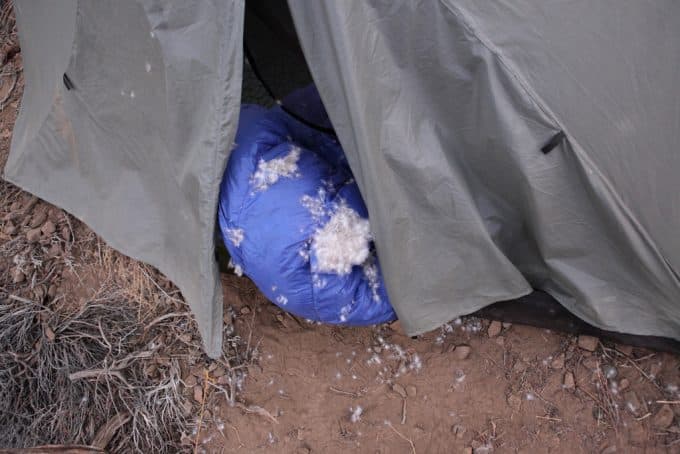
To mitigate the onerous cleaning negative we simply recommend that you shower (or jump in a river) to get clean before you go to bed at night. You’ll feel better being all clean before bed anyway, and it will add years to the life of your sleeping back – down filled or otherwise.
The Price
So you’re aware of both the pros and cons of down filling, and have decided it’s for you? Well, now let’s talk price. The range when it comes to down sleeping bags is quite expensive. From specialized high altitude designs for the climbers of Everest in the thousands right through to < $100 special deals on Amazon. Unless you’re a summit conqueror or on a tight budget, we’d recommend you aim somewhere in between the two extremes.
It’s better to overshoot than undershoot in terms of quality because this is likely to affect your sleeping bag’s durability and comfort – two very important factors. The main difference is likely to be in the down filling itself.

More expensive down sleeping bag models will be composed of feathers from mature geese. These feathers are the most fine, soft and lofty ones available and make absolutely fantastic insulators. Pack on top of this, a higher than normal fill power, and you’ve got a great high class model sleeping bag that’ll keep you nice and cozy.
Note: Fill power is the measure of how effective down is as an insulation material. It generally measured how many cubic inches one ounce of down can fill and ranges from around 500 to 900, low quality to high quality respectively. It matters in regard to weight as a 700-fill power sleeping bag with a +20 degrees Fahrenheit rating, will weigh less than the same degree rating level bag with only 600 fill-power.
Conclusion
If you can afford to, and you don’t have any allergy issues or an inability to clean yourself properly before going to bed at night, then a down filled sleeping bag is for you. These easily transportable warm wonders are great camping, hiking and mountaineering companions that have been in use since forever. They get a big thumbs up from us.

Now that you understand what down has to offer you, it’s important to also investigate synthetic filled sleeping bags. They have their own host of factors, read on to find out what they are.
The Characteristics of Synthetic Filling
What characteristics need to be considered before choosing synthetic sleeping bag.
The Basics
Synthetic filling is man made. It was created to mimic the positive qualities of natural down filling while eliminating some of down’s negatives. Most synthetic fillings, are made with polyester fibers, combined into a variety of filament sizes and intertwined to create clusters with a range of loft levels.
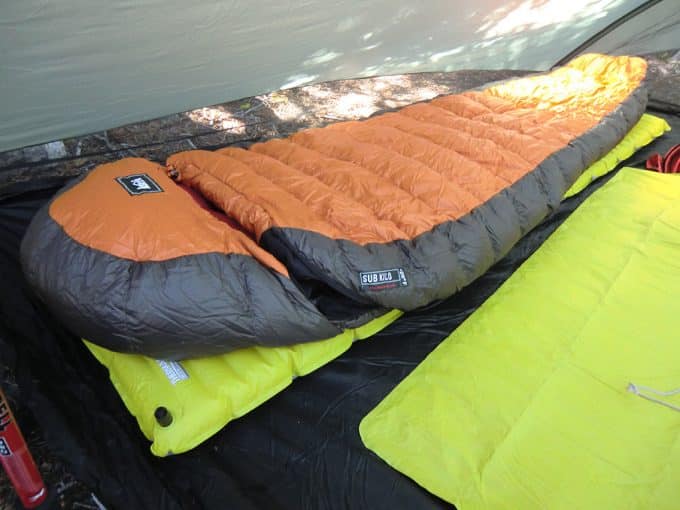
They effectively replicate down, but using a man-made substance. The key thing to be aware of when shopping synthetic is the distinction between short-staple and continuous filament.
- Short staple insulation: This synthetic filling is comprised of short strands of super refined denier filaments that are packed very close together to ensure maximum heat retention. You’ll find sleeping bags filled with these feel very soft and flexible – much like down.
- Continuous filament insulation: This synthetic filling is created from thicker filament which is very durable and strong. It is likely to have a stiffer feel than short staple insulation and be less compressible as a result. Also, there can be cold spots in its composition. Fortunately, it is more durable than short staple insulation, though, so take your pick.
The Pros
If you’re a fan of either of the above types of synthetic filling mentioned above, then you should know their’s even more to the package. Here’s a quick list of the general positive characteristics of synthetic fillings on a whole:
- Fast drying
- Less expensive than down
- Hypoallergenic
- Provides insulation even when it is wet
The hypoallergenic characteristic of synthetic sleeping bags is a real drawing card for many allergy sufferers who are trying to enjoy the great outdoors. Suprisingly, it is the unnatural substance (synthetic filling), not the natural substance (down) that best serves to alleviate allergies overnight.

This is because polyester is fundamentally different from down and has been designed with allergy sufferers in mind. You’ll find that certain sleeping bag brands have tailored their product specifically to the allergen marketplace. So if you’re not a fan of dust mites then synthetic filling may be for you.
The other key factor synthetic filled sleeping bags have over down filled ones, is their ability to dry quickly. Some will even dry in a couple of hours if placed in direct sunlight.
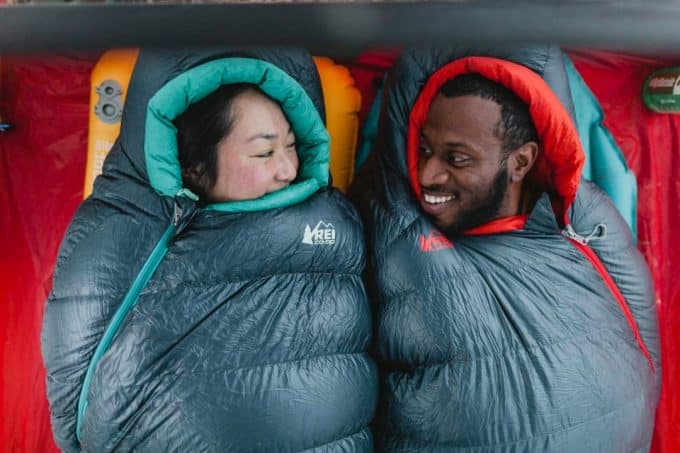
This makes them great long-term camping companions – especially in rainy areas where a little bit a moisture in your tent is inevitable.
The Cons
Though it’s mostly hunky dory, there are a couple of places where synthetic filling can come short when compared with down for the purpose of sleeping bags. These are the negative characteristics of synthetic filling:
- It has a higher weight-to-warmth ratio than down
- It may not be as durable as down
- Insulation power is slowly reduced over time as it gets less, each time your sleeping bag is stuffed back into its sack.
The higher weight-to-warmth ratio of synthetic filling when compared with down filling may not necessarily be a problem for you. All this means is that to achieve the same level of warmth as a down filled sleeping bag a synthetic one will need to be heavier.

So if you’re planning on staying put in one area (or are a total buff) then this won’t be a problem. Alternatively, if you’re going for long hikes with your sleeping bag in your pack then synthetic fillings may not be perfect for you.
The other negative of a synthetic filling in sleeping bags is entirely a matter of the price point at which you buy them in. Generally speaking, though synthetic, sleeping bags are considerably less expensive than down ones and their exterior and other fittings may thus be made by the manufacturer at a lower quality.

It’s important to check that your sleeping bag zip and outer lining will stand rough handling – especially if you’re going to take it out in the wild with you. There’s nothing worse than a sleeping bag that breaks mid trip. To mitigate this risk you could simply go for a higher end synthetic sleeping bag model.
The Price
So long as you’re not put off by either of the above cons, synthetic sleeping bags are likely to be the perfect option for you. They come in a wide range of prices, but the majority of those on the market tend to be in the cheaper < $250 range. We know that may not sound cheap, but this sleeping bag could last you for many years to come!
As always, we’d recommend going slightly higher instead of lower in terms of budget. Make sure that you check out the manufacturer’s warranty – if they’re willing to ensure their product then that’s a pretty good indication of its makeup.
Conclusion
Synthetic sleeping bags have added a strong alternative to down in the sleeping bag marketplace. They offer a realistic alternative to down in wet outdoor conditions and provide a welcome relief for allergy sufferers.

Overall, we’d say they’re a great choice, provided that you aren’t needing to carry them long distance on your back. Best use case scenarios include camping, extra bedding and travel companions. So synthetic fillings have something to offer too! But wait, there’s more. Below we capture the third and possibly best option yet.
The Blended Magnificence
What if you could have all the benefits of both down and synthetic fillings in your sleeping bag, without any of the cons? Well, you can! Enter the special ‘blended’ filling bags. These sleeping bags contain both down and synthetic filling in appropriate proportions and placements.
The synthetic filling generally makes up a thin outer layer of filling, so that the part of the sleeping bag that is more likely to get wet/damp will be able to dry quickly. The center of the bag is then composed of pure down filling, meaning overall the sleeping bag is still very warm and is also incredibly lightweight and compressible.
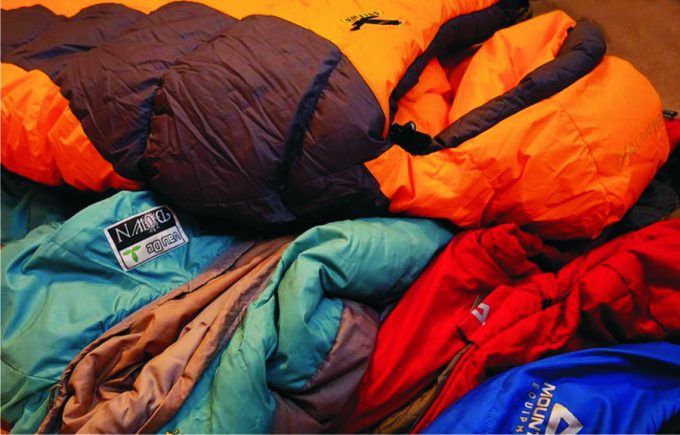
We were very impressed by the invention of blended sleeping bags and believe they will be the next big thing on the market. They sit in the higher price range point, but are well worth it, and they’re still usually cheaper than pure down. For avid adventurer’s who want a bag that will do everything from camping to hiking to scaling mountains with them, a blended bag is your best bet.
Note: What you’ve just learnt about sleeping bag fills can be applied to a variety of other outdoor products as well. Everything from full winter jackets to pillows can be found with either down or synthetic stuffing. Now that you know the pros and cons of both, you can choose the best outdoor equipment for you.
And remember, it’s not the filling itself that creates warmth, but rather the fact that it catches your body heat in it’s air pockets. So the more puffy that pillow or winter jacket, the more warm it’s likely to be.
Our Closing Comments
When you’re out there on the market looking at which sleeping bag to buy, the most important part of your decision will be choosing a filling type. Your choice will affect the warmth factor, overall weight, water resistance, size and price tag on your new sleeping bag.

Both down and synthetic insulation, are good in their own rights – it all depends on your own personal intentions for the use of your sleeping bag. Whether it’s camping or hiking or something in between, these two types of fills, have you covered. Down is possibly a little more luxurious and comfortable, whereas synthetic fillings can be more practical.
We’d personally recommend the blended bags as being the most multi-purpose and beneficial in all situations. With one of these you can switch from rainy whether camping one weekend to hiking the next and boat trip on the third.
It’s about giving yourself the freedom to develop your outdoor adventure tastes over the years while maintaining a constant sleeping bag companion. It is an investment after all, so getting one that will go the distance and adapt to suit you over the years is worthwhile.
